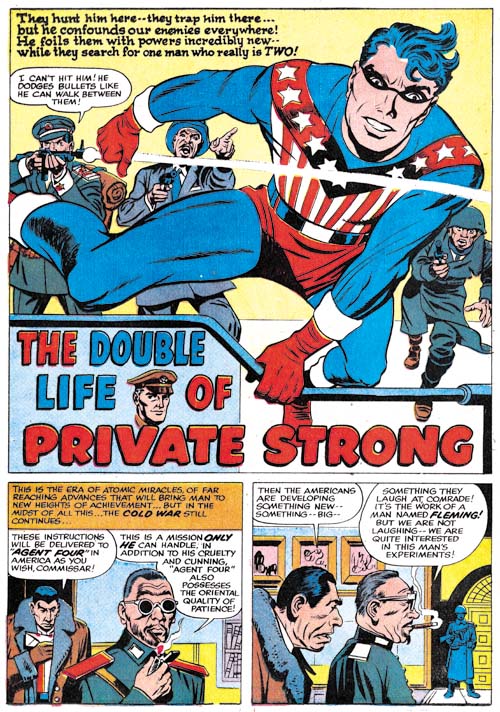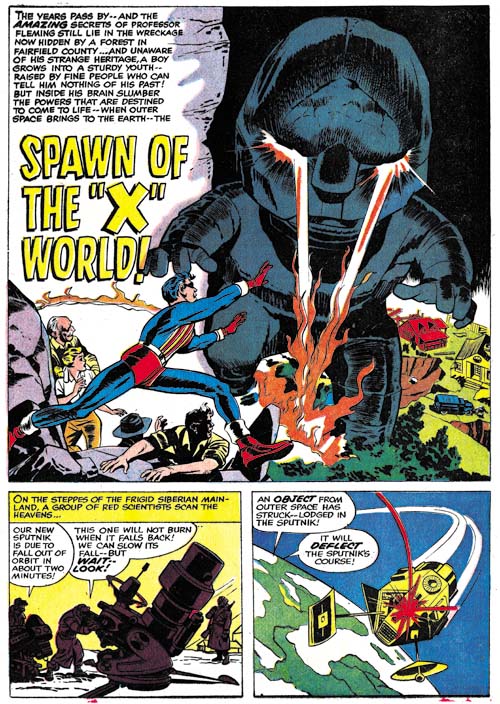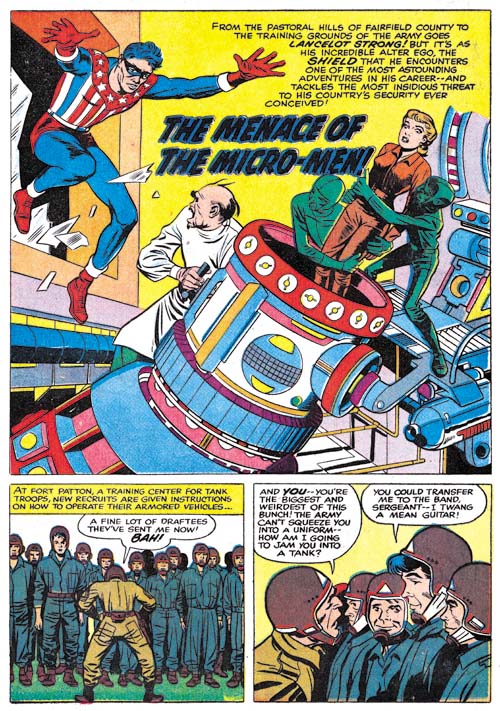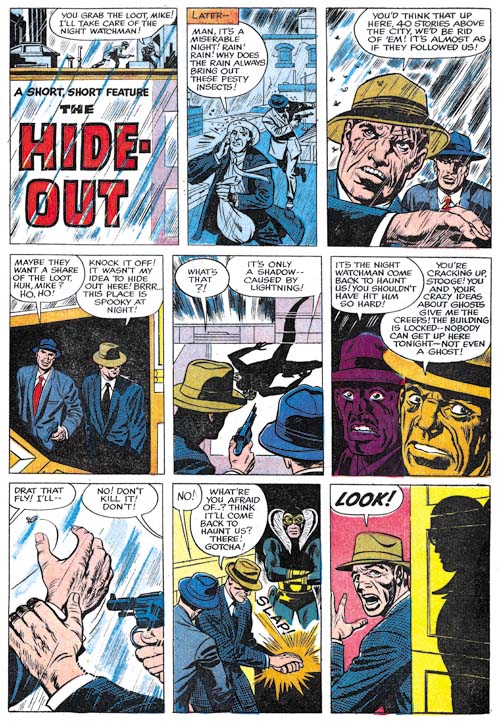For me it is still an open question exactly when the Simon and Kirby studio dissolved but it certainly had by the end of 1956 because Jack had begun doing freelance work for DC and Atlas. That did not mean the end of Simon and Kirby collaborations as Jack did most of the art for Race for the Moon issues #2 and #3 (September and November, 1958). Even though Joe and Jack were clearly not working in the same studio, I consider these issues of Race for the Moon to be the same sort of collaboration that had been done in the past. Certainly the results looked very much the same. However Race for the Moon was not very successful; actually none of the work Simon and Kirby did for Harvey Comics ever were.
In the early days of the silver age of comics DC had shown that once again there was money to be made in superheroes. John Goldwater, president and part owner of Archie Comics, thought it might be a good idea for his company to try superheroes again. Actually Archie Comics had started with superheroes only at that time the publisher called itself MLJ. Their flagship comic, Pep, featured the Shield, the first patriotic superhero. Simon and Kirby had even produced a cover for Shield Wizard #7 and (perhaps inadvertently) redesigned the Shield’s costume.
Goldwater approached Simon to create two new titles and Joe came up with up with the Fly and the Shield. Although they shared the same name, Joe’s Shield was to be a very different character. After receiving Goldwater’s approval, Joe approached Kirby to provide some initial art work. Now this work can properly be called collaborations but the collaboration was nothing like what had occurred before and the results looked very different. While I am sure that Kirby had made significant creative contributions to the stories he worked on he was doing so with directions from Joe. In the past the inking of Jack’s pencils either involved Jack himself or was done by others in similar style. But for the new Archie titles Jack supplied only the pencils and all the inking was done in a more modern silver age style. Also Joe lined up other artists to work on the titles so it is clear Kirby was only meant to work on the initial issues.

Double Life of Private Strong #1 (June 1959) “The Double Life of Private Strong”, pencils by Jack Kirby
The new Shield appeared in a comic with the awkward title “The Double Life of Private Strong” with Jack Kirby providing all the story art. Besides great strength, the new Shield could fly, throw lightning bolts, run rapidly and see in the dark; perhaps there are some other powers that I have forgotten. In some respects the origin story is a variation on the Superman origin. The main difference is that the new Shield was not an alien but acquired his powers as a result of being the subject of his father’s experimentation. However he ended up an orphan found and adopted by a farming couple. Basing the Shield’s origin on that of Superman’s may have had negative consequences.

Double Life of Private Strong #1 (June 1959) “Spawn of the ‘X’ World”, pencils by Jack Kirby
The stories in issue #1 are actually chapters in one long origin story. The first story dealt with Lancelot’s youth in the next, “Spawn of the X’ World” we see his discovery and first use of his powers. At the beginning of the story Lancelot is accompanied by a friend, Spud, but at the end of the story we find that while Lancelot was off saving the world Spud was in critical condition having been caught in a fire. Some comic experts have tried to equate this with the death of Uncle Ben in the Spider-Man origin story. However it just does not wash. Uncle Ben’s death was the result of Spider-Man’s unwillingness to intercede in a crime while Lancelot was very much fulfilling the role of a hero when he left Spud. Further it is not clear that Spud would in fact die as the policeman says that they will try to save him. And if that was not enough, Lancelot does not seem that remorseful (“if only the Shield had known”) and was more concerned about learning about his powers.

Double Life of Private Strong #1 (June 1959) “Mystery of the Vanished Wreckage”, pencils by Jack Kirby
The next “chapter” begins with Lancelot and a friend. Is the companion Spud? It is not clear but the person had been told of Lancelot’s deeds except he just does not believe it. At the end of “Mystery of the Vanished Wreckage”, Lancelot has received a draft notice.

Double Life of Private Strong #1 (June 1959) “The Menace of the Micro-Men”, pencils by Jack Kirby
The final story of the issue takes place when Lancelot has just entered the army. It involves a villain who is able to shrink men, a theme that Kirby has used before (Yellow Claw #3, February 1957, “The Microscopic Army”).
The origin stories that Simon and Kirby produced had evolved as their career progressed. For Captain America the origin story seems little more the something to get past as quickly as possible. Greater attention was paid for the origin stories of the Newsboy Legion, Manhunter and the Boy Explorers but they still occupied a single 10 to 13 page story. For Boys’ Ranch Kirby drew an impressive 17 page story. For Fighting American the origin was broken into two stories; the first detailing how the hero came to be Fighting American and the second how he acquired his sidekick, Speedboy. With Private Strong and the Fly the origin story would be spread out over several stories in the first issue. As far as I know this early use of continuity, limited though it was, cannot be found in any other comics before the Marvel age. Unfortunately neither Kirby nor Simon seem to realize what they had stumbled upon and once the origin story was over, so was any real continuity.

Double Life of Private Strong #1 (June 1959) “The Hide-Out”, art by Jack Kirby
The first issue also had a single page feature, “Tommy Troy Teaches Judo”. The first Fly comic had not been released yet so at the bottom of the page announces “see more of Tommy Troy in Adventures of the Fly”. I do not know who the artist was. Nor can I identify the artists who provided illustrations for the required text piece except to say it was not by either Simon or Kirby. “The Hide-Out” was a two page promo for the Fly also drawn by Kirby. Despite its short length (15 panels) it is really a nice piece. Kirby always seemed to give his work his best effort no matter the length.
I’ll write about the second issue next week.


Harry,
Do you know if “The Double Life of Private Strong” was always supposed to be the title, or did the publisher see similarities with Superman and want to distance himself as much as possible from a superhero name?
No, but I may go into more details in my next post.